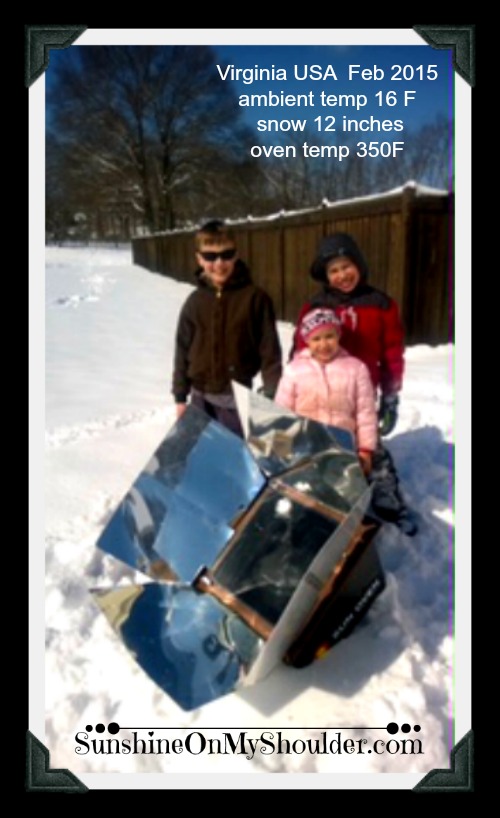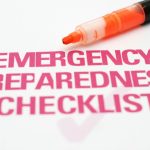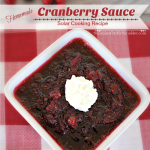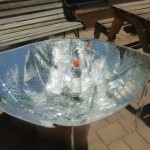Solar Cooking In an Emergency
Solar cooking is becoming more mainstream. A few years ago, I had never heard of solar ovens and solar cooking. And I really had to search for solar ovens. Today. there are numerous websites devoted to the issue. You can now find many different types of cookers – either to buy or to make yourself. When the benefits of solar cooking are discussed, generally it is promoted as great for camping and other outdoor adventures; or the personal savings on utility bills due to lower energy costs from not heating up the kitchen oven or the house; or the benefits being reaped from solar cooking in underdeveloped countries. And finally, mentioned at the end, will come a little verbiage about emergency preparedness.
Emergency Preparedness
While all of these reasons are great, I believe the number one reason to solar cook is to be self-sufficient in an emergency. When we think about being prepared for emergencies, generally the largest of largest disasters fill our thoughts – 9/11, Hurricane Katrina, etc. But there are other emergencies and other disasters. One year, the East Coast saw several large scale power outages. My daughter and her family live in Virgina, close to D.C. One night, a very large, very destructive storm hit the East Coast. Hundreds of thousands of people were without electrical power. Not just homes – but restaurants, stores, gas stations – every one. Best estimate on getting the power restored was 3-4 days Whether the power is out because of a winter storm – think freezing cold – or because of a summer storm – think sweltering heat – it is not an easy situation, and somehow you still have to feed a hungry family. You can cook on a grill until you run out of charcoal or gas. You can cook over a fire until you run out of firewood. But you can cook in a solar every day that the sun is shining.
Power Outages
But it doesn’t take a storm to compromise the electrical grid. Here in the middle of the Arizona desert, our power has been knocked out from extreme high demand on the system during the summer. Also, one year a large transformer exploded. It was weeks before another could be trucked in and hooked up to replace it. Parts of the Phoenix area were without power that entire time.
Purify Water
Even if there is power, solar ovens are useful in other emergency situations as well. A solar oven can be used to heat and purify water. Although a solar oven will not remove contaminates, a solar oven can heat water hot enough to kill bacteria and parasites. Starting with clean, clear water, bring the water temperature to 165 degrees. Every solar oven that I have experience with gets hotter than that. Or bringing the water temperature to 145 degrees and maintaining it for 20 minutes will accomplish the same thing.
Solar ovens are a very necessary part of emergency preparedness. When the power goes out, what will you do? Whether you make one or buy one, get one and learn to use it. Because one never knows when the power will go out.
By the way, want to know what was in that sun oven in the snow? Chicken and rice casserole with a dump cake for dessert.
In conclusion, solar cooking in an emergency can feed your family, and provide safe water to drink.






I am enjoying my Haines Solar Cooker. It is inexpensive and collapsible.
Bill
Hello Bill, I like the Haines Cooker too. It is lightweight and portable, and it gets the job done. Thanks for stopping by and saying hello. Merry
Re: Emergency Solar Cooking
Here is some wisdom I picked up along the years from my own experience with prolonged power outages and from friends who survived Katrina, the Nashville flood, and other disasters (including the Colorado flooding of 2013).
Rule #1: Be Prepared.
Rule #2: Layer your emergency gear to work together as a system.
For example: I use the inner 7L pot from a Thermal Cooker. I painted the pot flat black with high temp flat black paint. When it is sunny I sit the pot atop my parabolic solar cooker and bring the contents to a boil. When it has boiled for about 10 minutes i place the pot back into the super insulated Thermal Cooker to finish cooking. A “Wonder Cooker” will work very well also, especially in a pinch.
However, when the sun is not available or the weather is less than pleasant, I use the same black painted pot and place it atop my StoveTec One Door Deluxe rocket stove – and VOLA! I can cook anything that a regular stove top range can cook, but by using my StoveTec I can do so entirely off the land using any bio-combustable fuel such as wood, twigs, pine cones, dried dung, brush, rolled paper, cotton, fabrics. etc. Thus I can cook day or night in any weather. Same as before I just bring the pot to a boil for a few minutes and then reinsert it into its ultra insulated housing and let it continue to cook and stay warm for many hours to come. Cost of the StoveTec Deluxe One Door stove is about $120 including shipping. StoveTec also offers a really nice 1 gallon rapid pasteurizer and a 1 gallon super high heat transfer cooking pot as integrated add-ons to the StoveTec stove system. Each piece costs about $60 and is totally well worth the money.
Further, if I need to cook indoors and have little or no ventilation, I simply again use the same black painted pot and just place it atop my single burner butane stove (because butane produces no carbon monoxide when it burns) and then place the black painted pot back into the Thermal Cooker.
And since I have three of the exact same Saratoga Jack’s Thermal Cookers, I can cook a meal in one, keep hot water and/or hot towels in another, and keep a hot soup or broth in the other, so in an emergency I can keep myself and my wife warm and well fed all night long, day or night, irrespective of the weather, with or without sunshine or electric power.
Add to this a couple of simple 5gal buckets and a Sawyer Point One water filter and I have Log 7 pure water from any water source, and the Sawyer Point One water filter fits into my shirt pocket and is good for 1 million gallons of super clean water.
You want your gear to work together in concert as one integrated system. Try to have each piece serve as many roles as possible and to have each piece of your equipment work with as many other pieces of your gear as possible. It is also very good to have some redundancy in regard to crucial pieces of gear (in case a piece breaks, or is stolen or damaged, or if you need to use it to barter for other supplies or gear during a crisis, or maybe to loan out to help a neighbor or family member or friend survive an emergency).
Now just stash back some MREs, some favorite canned foods & soups, a few P-51 can openers, some gallon jugs of sealed drinking water, a few days worth of your meds, a good LED flashlight (or two) and a few packs of AA lithium batteries, a few boxes of strike anywhere matches and several tea candles (all in in zip lock bags to keep them all dry and usable); a titanium spork or two, a couple of re-usable high quality mylar “space” blankets (like Heat-Sheets brand emergency blankets and bivvy sacks), and a change of clothes packed away into a waterproof stuff sack – and a few cases of Bud Tall Boys (during a multi-day crisis two cycle oil, beer, toilet paper and ammunition will buy you things that cash money or even gold will not. No joke. Research it). Also stash back a case or two of some sort of electrolyte fortified power drink like Gatorade, and some sports style power bars.
Keep written copies of all your important data and documents somewhere waterproof and safe. Keep things like credit card numbers, emergency phone numbers, contact info, medical info, etc, written on water proof paper (or paper that has been laminated front and back – after the important data has been written on it), and have a trusted family member who lives a good distance away from you keep a USB key drive or SD card with photo copies of all the same important information and documents, card numbers, medical info, and emergency contacts. By having such a USB drive or SD card safe in trusted hands miles away from your home, you greatly increase the odds, in your favor, of having access to them if all else fails or is lost.
Lastly, if you live in or near a big city, a pump 12 gauge shotgun and/or a 40 cal semi automatic pistol (Glock 40cal) with a few loaded spare mags is a very intelligent idea to have handy. Why? Because someone bigger and meaner than you may decide to try and take your emergency gear and supplies from you and your family, and/or attempt to sexually assault you or someone you love. If you have the firepower you can probably deter them – or stop them outright the hard way. If you do not have a firearm you may become what is called a “victim” and suffer the very unpleasant and possibly lethal consequences thereof.
Do a Youtube search for “bug out bag” and an Internet search for 72 hour emergency bag. Construct one for yourself – with a slightly different one for each individual member of your family. If each individual has their own 72hr bag, a wider array of equipment can be carried without unnecessary redundancy of gear, thus enabling you to address a greater diversity of situations with greater options, thus increasing the odds of your survival – and your comfort – during the crisis.
It pays off big to think ahead.
All it requires is a little time doing the research, investing in one or two pieces of equipment every month or two, and the willingness to be prepared – and the intelligence enough to actually do it.
I just did a big chunk of the task for you.
I hope this helps.
Excellent post. I’ve been doing demonstrations and having the folks make their own very disposable ovens so they can see the power of this wonderful alternate energy cooking. Little by little; step by step…. Come visit when you can.
Power is on now! I think we were the only ones in Northern Virginia that had freshly baked cupcakes today.